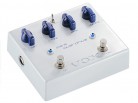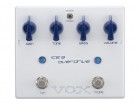First Impressions
The pedal itself is pretty large. It's about the width of two normal pedals, has four control knobs, and interestingly, two activation switches. The whole time I tested the pedal at the guitar store I kept looking at it as a Vox pedal and didn't even notice the Ice 9 silk-screened on the front. That would have told me that this pedal is endorsed by Joe Satriani. I like a lot of Satch's rhythm playing on his albums and obvious his leads are famous. What most people don't get is that its pretty tricky to get such a distinctive tone. Since half a player's sound comes from his hand and the rest from his gear you may never sound like Satch but that doesn't mean you won't achieve some amazing tone.
The layout of the knobs are Gain, Tone, Bass, and Volume. Couple of points to note, this is not a distortion pedal. Upping the gain knob isn't going to make your Fender Twin sound like a Marshall stack. What it will do is add a lovely effect that mimics the gain knob on an amp. You can't get to seriously distorted sound to play Pantera with this pedal, but you can get some amazing sounds. More on that later.
The two activation buttons are labeled On and More. Pretty self explanatory. On the very top of the pedal is a small switch labeled Vintage and Modern. Turns out that the modern setting uses a Germanium diode to create its effect while the Vintage mode relies on an ordinary diode. Germanium diodes are the stuff many distortion pedals are made with so now I was beginning to wonder what was going on with this pedal.
Using It
A lot of people wonder why I have an overdrive and distortion pedal. This is where lots of experience and experimentation come into play. Early on I used to play nothing but rock and usually I stuck to heavy metal. As I got bored playing the same stuff over and over I began to jam with guys who play everything under the sun: jazz, country, latin, etc. I found that having a distortion pedal was absolutely no help and that I was always running back and forth to my amp to make changes. I realized I needed to not only be able to distort my sound but I also needed what an overdrive pedal does: push the preamp tubes to overdrive slightly. This warms up the sound, sometimes creating a little grit in the sound, without going into full blown distortion. The fact that there is a little jump in volume is a nice bonus - you can activate an overdrive pedal for lead playing without changing your initial sound if you don't want to.
Once I placed the Ice 9 on my board I went straight up (12 o'clock) on all the settings and activated the 'on' setting. This thing was so much louder than my old overdrive pedal I was a little worried. I'd rather get my volume from the master control on my amp - having too much from my pedal board drives the preamp tubes too hard creating a harsher sound. I want my power tubes to give me the majority of my sound which means high master volume levels and the preamp tubes not being driven to insane levels. I found that lowering the volume down to about 1/4 on its dial got me back into my comfort zone.
The gain knob is a very useful knob on this pedal. As you increase it you get a nice smooth increase without becoming too wild. You can go from a jangly sound to a nice gritty blues all the way up to classic rock territory. Need a little more? Flip the switch from Vintage to Modern and you'll get a little more edge to the sound. To really notice the difference between Modern and Vintage you need to be playing at some high volumes on the amp. If you are at home practice levels the difference isn't really noticeable Open the amp up and flip that switch and suddenly you realize that the Germanium diode is there. I found with a guitar with single coil pickups I could get some very nice sounds just short of metal. Hook up my Les Paul and suddenly I could get into much thicker territory. Vintage has that nice sound you get from an old amp whose output transformer sags a little when pushed really hard.
The dual tone knobs - tone and bass- make for a very useful pedal. Ever try to adjust a single knob to control how bright or dark your sound is? I found that as I increased gain I could lower the bass a little for a smoother sound. Now we're getting into a lot of Joe Satriani's sounds. Lower bass even more and without too much gain and I hit Stevie Ray Vaughn country. Want even more distortion above your rhythm sound with more volume? That's what that switch labeled 'More' is for. It works perfectly to kick you up to lead levels. This means you can run the pedal always on to get your sound and still have an easy way to go into your lead tone.
Conclusions
I've always placed my distortion pedal after my overdrive pedal. This lets me drive that distortion pedal harder and get a lot more sound out of it without its settings being too high. Then, I could turn off the overdrive and only run the distortion pedal. This usually gave me a good rock rhythm sound. With the Ice 9 pedal and it's 'On' and 'More' setting I can probably delete my distortion pedal. Currently its still there and I'm playing with what I can now set my distortion pedal to. I've found I can go even lighter on my settings which lets me have more options when I'm playing. Can you sound like Satriani? Sure. But more importantly you can explore new sounds with your guitar and amp and see new options open up for your tone.
I have only one complaint about this pedal. I wish the knobs weren't so easy to turn. Normally not having to use your thumb to turn a dial is a good thing but these are so loose that a guitar cord brushing against them can rotate them. Same thing if your foot actually touches them as your trying to activate the switches. These knobs feel just like Vox's amp knobs which is great in that application - not so much in a pedal. It's happened a few times where suddenly I realize something has changed and I look down and all the knobs are askew from my settings.
With its huge range of tones I'm not going to go to another overdrive pedal anytime soon. Maybe for another twenty years or so.












